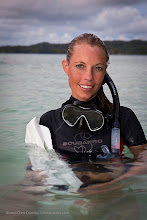
Out of sight out of mind, as the saying goes. This is why so many people are surprised when I tell them that many shark species are almost extinct. And nearly all are headed for disaster.
But, you can’t stop something so terrible from happening if you don’t know about it. Or know why you should care.
Over 100,000,000 sharks were killed last year – primarily for their fins. Indeed, their populations are down to critical levels and they are still being fished out of the ocean at a completely unsustainable rate. In fact, recent studies indicate regional populations of sharks are down by 95 – 99%. That is considered functional extinction.

Many don’t know about this issue, because it happens so far away from us. Out in the oceans, far from shore, far from our eyes and far from governmental protection. We assume sharks are protected in marine reserves or that it is some other country’s problem. Many of us may even live in countries in which certain types of shark fishing is illegal – though most likely it is still occurring right under our noses.
And, it happens for reasons that many of us are not familiar with: it happens for the incredibly valuable shark fin. The key ingredient in a tasteless, social climbing soup. It is known as Fish Wing Soup in Asia and is so highly sought especially given its cultural association with health, prosperity and good fortune, it can sell for upwards of $100 a bowl. And while the supply is plummeting, the demand for shark fin soup is at an all time high.

Yes, the incredibly lucrative market for shark fins is driving the slaughter. And this industry full of greed and corruption is often likened to the illegal drug trade as it is rife with murder, mafia, and millions of dollars. Fisherman desperate to feed their families are being driven to extremes, and it is only a handful of individuals who are benefiting – at a incredible cost to all of us.
We have seen it before. All the factors are there for a global species extinction.
And once they know the fate facing sharks, many people throw up their hands and wonder why they should care, already convinced the only good shark is a dead shark after watching movies like Jaws and shows on Shark Week. Hasn't the media taught us that sharks are blood-thirsty, indiscriminant monsters with an insatiable hunger for human flesh? Should we really care if they disappear? Wouldn’t the world just be a better place?

Then comes the next surprise: contrary to all of the rubbish we have been taught, we are not on the sharks’ menus. In fact, of 6.5 billion people that live on this planet, only one died last year from a shark bite. One. Compare that to the amount of people who die from lightening strikes, car crashes, hunger, even falling coconuts and you realize there are many things to be worried about – but sharks are not one of them. Of the over 500 species of sharks, only a handful have ever even had encounters with humans. The truth? Sharks are magnificent creatures that are more scared of us than we could ever be of them.
If only we could let our fears go and realize sharks are misunderstood creatures that desperately need our help.
Maybe if we realized how brutal it is to fin a shark we might also care a bit more. Tragically, sharks are dragged while alive onto fishing boats where a knife with a hot blade is used to slice off all of the shark’s fins. Then, the shark is thrown back into the ocean still alive to bleed to death – or drown.

Maybe if we knew that while we collectively enjoy our shark steaks, shark fin soup, or shark cartlidge, that instead of being healthy we are actually poisoning ourselves, we might stop endlessly creating demand. Because sharks have levels of methyl-mercury in their flesh that is so high, a single shark steak can cause mercury poisoning, leading to sterility, nervous system issues and birth defects for those that consume it.
Or maybe if we realized that sharks keep our largest and most important ecosystem healthy – an ecosystem that provides us with much of the air we breath and food we eat – we might realize our existence, in part, is dependent on theirs. Sharks have sat atop the oceans’ food chain, keeping our seas healthy and balanced for 450 million years. Those oceans absorb most of the carbon dioxide that we put into the atmosphere, converting it into 70% of the oxygen we breathe. The oceans also supply us with a large percentage of the food we eat – including serving as feed for many farmed animals. Yes, all that life is kept healthy by sharks, who, as apex predators, regulate the oceans. Destroying shark populations is destroying our oceans - our very life support systems – and thus, ourselves.
We don't hear how the elimination of sharks might impact our best natural defense against global warming. Or how our favorite foods might disappear as a side effect of the extinction of sharks. Or that we could lose more oxygen than is produced by all the trees and jungles in the world combined if we lose our sharks.
So whether you are like us and you absolutely love sharks and cannot imagine an ocean without them, or you simply realize the loss of the sharks from this planet has huge, far-reaching implications that cannot be ignored, the time to act is now. We must work together, fight this war and save our sharks.
(Photos courtesy of Jeff Rotman.)


















